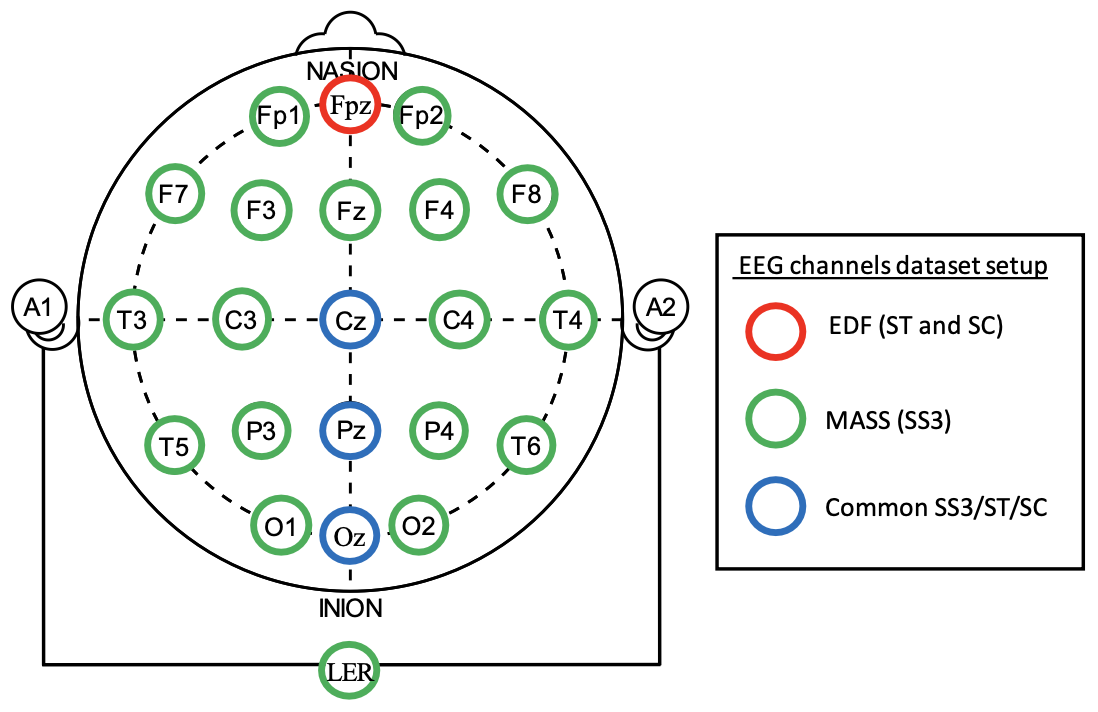Samuel Michel: Generalizable Automatic Classification of Sleep Stages
Posted on Sun 30 July 2023 in theses

This figure illustrates the EEG channel configuration for the selected datasets. While EDF-ST and EDF-SC share the same channels, only three channels are common between MASS (SS3) and EDF (ST and SC).
The gold standard to diagnose sleep disorders is called polysomnography (PSG). A PSG consists in sleeping one or several nights, at a hospital or a sleep center, while wearing different sensors continuously measuring various temporal data (e.g. electroencephalograms, electrocardiograms, electromiograms, oxymetry, respiration rate, etc.). These data are then used by an expert to annotate the PSG (hypnograph) into the differente sleep phases (paradoxal summation, light, moderate and deep sleep). The hypnograph is then used for sleep disorder diagnosis. The manual annotation process is affected by human limitations: it is time consuming, tedious, not reliable, sensitive to the setup of the different clinics, and to motion noise. Indeed, each sleep center defined his own setup for the PSG. Moreover, it happens that one data is lost due to a motion of the patient during the night (noisy data). Regarding the reliability different studies have shown that for the same PSG two experts may annotated differently. The aim of this work is to investigate the possibility to automate the classification of PSG into the different sleep phases using machine learning. The main concern will focus on the capacity of such algorithms to be faster, and more reliable than manual scoring. To perform this study, two follow-up questions will gravitate around the main scientific question. We will focus on models which are robust to the setup of different clinics, noise and are fair to different populations. One of the steps of our work is therefore to analyse the ability of an automated classifier to manage data coming from different sleep centers. We scoped this study to stateless models that do not take into account temporal context. We investigated both hand-crafted and learnable feature extractors. In terms of intra-database performance, our best model was the CNN Chambon model proposed by Chambon et al. in their paper [1]. However, when evaluating generalization across different setups, the random forest model with manually chosen features described in the same paper emerged as the best model.
Reproducibility Checklist
Software with preset configurations to reproduce published findings.
All databases are publicly available
Bibliography
[1] Stanislas Chambon, Mathieu N. Galtier, Pierrick J. Arnal, Gilles Wainrib, and Alexandre Gramfort. A Deep Learning Architecture for Temporal Sleep Stage Classification Using Multivariate and Multimodal Time Series. IEEE Transactions on Neural Systems and Rehabilitation Engineering, 26(4):758–769, April 2018. doi:10.1109/TNSRE.2018.2813138.
@article{chambon-2018,
author = "Chambon, Stanislas and Galtier, Mathieu N. and Arnal, Pierrick J. and Wainrib, Gilles and Gramfort, Alexandre",
title = "A {Deep} {Learning} {Architecture} for {Temporal} {Sleep} {Stage} { Classification} {Using} {Multivariate} and {Multimodal} {Time} { Series}",
volume = "26",
issn = "1534-4320, 1558-0210",
doi = "10.1109/TNSRE.2018.2813138",
abstract = "Sleep stage classification constitutes an important preliminary exam in the diagnosis of sleep disorders. It is traditionally performed by a sleep expert who assigns to each 30 s of signal a sleep stage, based on the visual inspection of signals such as electroencephalograms (EEG), electrooculograms (EOG), electrocardiograms (ECG) and electromyograms (EMG). We introduce here the first deep learning approach for sleep stage classification that learns end-to-end without computing spectrograms or extracting hand-crafted features, that exploits all multivariate and multimodal Polysomnography (PSG) signals (EEG, EMG and EOG), and that can exploit the temporal context of each 30 s window of data. For each modality the first layer learns linear spatial filters that exploit the array of sensors to increase the signal-to-noise ratio, and the last layer feeds the learnt representation to a softmax classifier. Our model is compared to alternative automatic approaches based on convolutional networks or decisions trees. Results obtained on 61 publicly available PSG records with up to 20 EEG channels demonstrate that our network architecture yields state-of-the-art performance. Our study reveals a number of insights on the spatio-temporal distribution of the signal of interest: a good trade-off for optimal classification performance measured with balanced accuracy is to use 6 EEG with 2 EOG (left and right) and 3 EMG chin channels. Also exploiting one minute of data before and after each data segment offers the strongest improvement when a limited number of channels is available. As sleep experts, our system exploits the multivariate and multimodal nature of PSG signals in order to deliver state-of-the-art classification performance with a small computational cost.",
language = "en",
number = "4",
journal = "IEEE Transactions on Neural Systems and Rehabilitation Engineering",
month = "April",
year = "2018",
pages = "758--769"
}